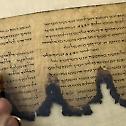Largest Ever Dead Sea Scroll Collection to be Unveiled at Texas Seminary
Visitors at the Southwestern Baptist Theological Seminary's exhibition, "Dead Sea Scrolls & the Bible: Ancient Artifacts, Timeless Treasures" in Forth Worth, Texas, will be able to view the largest Dead Scroll fragments to ever be placed on public display starting July 12.
"The chance to view portions of the Dead Sea Scrolls usually requires an overseas trip to a Near East nation, such as Israel or Jordan," said Bruce McCoy, the exhibition director.
The elaborate display will include the Genesis 37-38 fragment, which is owned by the Kando family of Bethlehem and is considered to be the largest Dead Sea Scroll segment held by a private collector. Five other major fragments will also be on display, including Genesis 33, 1 Kings 13:22-22, Isaiah 28:23-29, Amos 7:17- 8:1 and Joel 3:9-10.
These fragments account for only the latest additions to the impressive ancient artifact display – passages from Nehemiah, Ezekiel, and Jonah are all also featured, and with the help of the Green Collection and the Hebrew University of Jerusalem, Southwestern's total display has reached 21.
In addition, other rare and interesting artifacts that will be present at the MacGorman Performing Arts Center will include the Isaiah scroll, the Habakkuk Commentary, the Manual of Discipline, and the full Copper Scroll, which were all found at the archaeological site in Qumran where the Dead Sea Scrolls were discovered.
"What I try to get people to understand is, there is a prior question to the 'Is the Bible true?' question, and that is, 'Is what we have the Bible?'" asked Weston Fields, guest curator for the "Dead Sea Scrolls & the Bible" exhibition and executive director of the Dead Sea Scrolls Foundation .
"The scrolls give us a 2,000-year-old snapshot of how the text of the Bible was in Jesus' day," he continued. "If there had been cameras, somebody could have stood next to Jesus, taken a picture of the Torah Scroll that He was holding up in the synagogue, put that picture in a vault somewhere for 2,000 years – nobody got a chance to see it, nobody could change it – and all of a sudden, you open up the vault 2,000 years later and say, 'Look, here's a picture of Jesus holding the scroll and look at the text.'"
The Dead Sea Scrolls, which represent 825 to 870 separate scrolls written mostly on animal skin, were discovered in caves on the shores of the Dead Sea between 1947 and 1956. They were mostly written in Hebrew, Aramaic and Greek, and contain both biblical and non-biblical passages, including prophecies by Ezekiel, Jeremiah and Daniel, which are not found in the Bible.
Source: pravoslavie.ru


